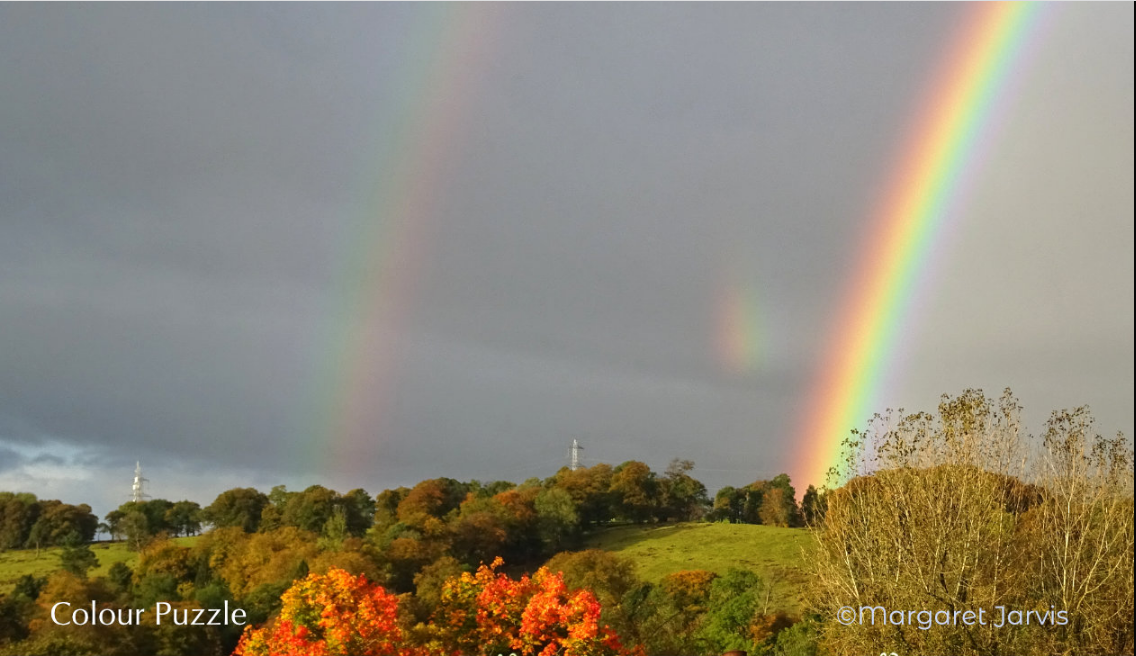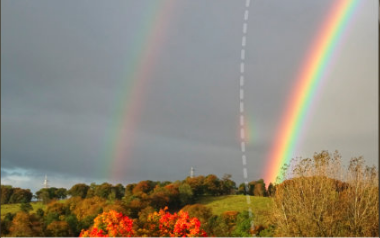Reflection rainbow
Reflection Rainbow: A Phenomenon of Light and Water
Rainbows have long captivated our imaginations with their vibrant colors and ethereal beauty. But did you know that there is more to rainbows than meets the eye? One fascinating aspect of atmospheric optics is the reflection rainbow, which occurs when sunlight reflects upwards from a mirror of calm water. In this article, we will delve deeper into the intricacies of reflection rainbows and explore the science behind their formation.
The Puzzling Patch of Color
In a captivating photograph taken in western Scotland, Margaret Jarvis captured not just one, but two bright rainbows with a mysterious patch of color between them. This color patch remained consistent in its position relative to the rainbows in multiple images, ruling out any artifacts caused by false reflections. To ensure the authenticity of such phenomena, it is essential to observe them with the naked eye rather than solely relying on the camera viewfinder.
Unraveling the Mystery
The positioning of the rainbows high in the sky suggests that the sun was low during the photograph. A hill partially obscures the true horizon, which lies somewhere near the lower edge of the image. The color patch, resembling a displaced fragment of a primary rainbow, exhibits vertical or tilting color bands in the opposite direction. These observations strongly indicate that the color patch is, in fact, a fragment of a reflection bow.
Sunlight's Dance with Water
To understand reflection rainbows, we must first recognize that raindrops act as tiny prisms that refract and reflect light. When sunlight passes through raindrops, it creates two suns: one in the sky and another below the horizon within the water. These dual light sources give rise to two sets of rainbows, with the bows intersecting at the horizon. In the case of reflection bows, they are formed by sunlight reflecting upwards from a calm water surface.
The Perfect Conditions
The creation of reflection rainbows requires specific conditions to align harmoniously. Smooth and undisturbed water serves as the mirror for the reflection, while the angle of the sun plays a crucial role. In the photographed scene, the image was taken soon after sunrise when the sun was approximately 8 degrees high. Behind the camera were three small lochs, with one of them positioned between the sun and the camera. This arrangement created an ideal scenario for the formation of reflection rainbows.
A Colorful Match
Returning to the captivating color patch between the rainbows, it is fascinating to note that it perfectly matches the predictions based on the sun's angle and the presence of nearby lochs. The vertical or tilting color bands observed in the patch further reinforce its identity as a fragment of a reflection bow. The intricate interplay between light, water, and atmospheric conditions gives rise to these mesmerizing optical phenomena.
Unveiling Secondary Reflection Rainbows
Upon closer examination of the photograph, extreme color subtraction enhancement reveals yet another color patch, this time indicating a secondary reflection rainbow. This secondary reflection occurs due to additional reflections within the water, creating a secondary set of bows. The discovery of this secondary reflection adds another layer of complexity to the already captivating world of atmospheric optics.
In conclusion, reflection rainbows are a captivating phenomenon that occurs when sunlight reflects upwards from calm water surfaces. The interplay between light, water, and atmospheric conditions gives rise to these mesmerizing optical displays. Through careful observation and understanding of the underlying science, we can unravel the mysteries behind these ethereal rainbows and appreciate the beauty that nature has to offer. So, the next time you find yourself near a calm body of water, keep an eye out for the enchanting dance of light that may unfold before you - a reflection rainbow.

Margaret Jarvis took this in western Scotland. Two bright rainbows and a puzzling patch of colour between them.
The image was taken through a window with a danger of false reflections. However, several hand-held images were captured and the colour patch remained the same position relative to the bows in all of them. Always do this to discount artefacts - they move with the camera. Be sure also that you see the effect with your unaided eye rather than just in the camera viewfinder!

The bows ride high in the sky. The sun was therefore low. A hill masks the true horizon which is somewhere near the picture's lower edge.
The colour patch looks like a displaced primary bow fragment. However, its colour bands are vertical or tilting in the opposite direction.
All this strongly suggests a fragment of a reflection bow. Just a fragment of a complete bow could be produced by a small area of smooth water.
Reflection bows result when sunlight reflects upwards from a mirror of calm water.
Raindrops see two suns - one in the sky and another the same distance below the horizon in the water.
The two suns make two sets of rainbows. The bows cross at the horizon.
Further details from the photographer revealed that the image was taken soon after sunrise with the sun 8 degrees high. Behind the camera were three small lochs with one of them on the line between the sun and the camera. The diagram at right is for the 8 degree
high sun.
The colour patch nicely matches the prediction.
Further details from the photographer revealed that the image was taken soon after sunrise with the sun 8 degrees high. Behind the camera were three small lochs with one of them on the line between the sun and the camera. The diagram at right is for the 8 degree high sun.
The colour patch nicely matches the prediction.



Extreme colour subtraction enhancement shows up another colour patch (arrowed).
This one is a secondary reflection rainbow.
Note: this article has been automatically converted from the old site and may not appear as intended. You can find the original article here.
Reference Atmospheric Optics
If you use any of the definitions, information, or data presented on Atmospheric Optics, please copy the link or reference below to properly credit us as the reference source. Thank you!
-
<a href="https://atoptics.co.uk/blog/reflection-rainbow/">Reflection rainbow</a>
-
"Reflection rainbow". Atmospheric Optics. Accessed on December 22, 2024. https://atoptics.co.uk/blog/reflection-rainbow/.
-
"Reflection rainbow". Atmospheric Optics, https://atoptics.co.uk/blog/reflection-rainbow/. Accessed 22 December, 2024
-
Reflection rainbow. Atmospheric Optics. Retrieved from https://atoptics.co.uk/blog/reflection-rainbow/.